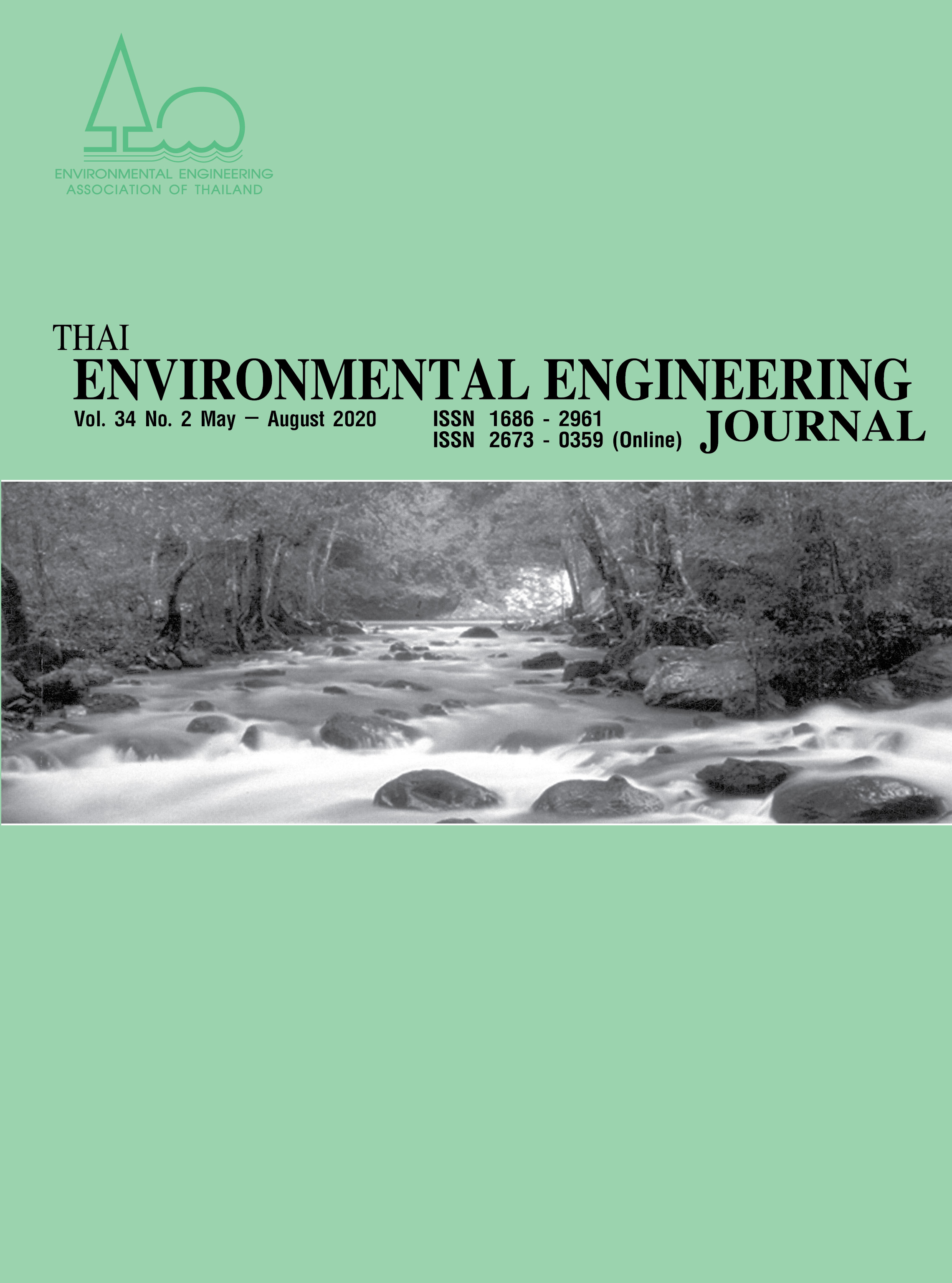Optimization of Washing Conditions and Adsorption Process for Petroleum Hydrocarbon Removal from Drill Cuttings Byproduct
Main Article Content
Abstract
Drill cuttings contaminated with total petroleum hydrocarbon (TPH) are generated from oil and gas exploration and production. The treatment of drill cuttings through washing process has been applied due to its high efficiency and less energy consumption. However, this process generates washing solution containing TPH as a petroleum waste, which requires further management. Therefore, the purpose of this study is to optimize the drill cuttings washing process using ethyl lactate (EL) as a green washing agent. Afterwards, the spent washing solution was purified through an adsorption process using two adsorbents: coal-based and coconut shell-based granular activated carbon (GAC). The result showed that liquid-to-solid (L/S) ratio was the most influential factor affecting the removal of TPH from drill cuttings by EL. The higher volume of EL used, the higher TPH extraction capacity. The mixing speed followed by washing time and rinse-to-solid (R/S) ratio also significantly affected the TPH removal efficiency, whereas the rinsing time was statistically insignificant. The optimum washing conditions were L/S ratio of 10 mL/g, washing time of 20 min, mixing speed of 100 rpm, R/S ratio of 10 mL/g, and rinsing time of 1 min, from which the TPH removal of 87.6% was achieved. For the adsorption experiments, coal-based GAC performed better in adsorbing TPH from the spent washing solution compared to coconut shell-based GAC. Thus, the overall results suggest that EL was a promising agent for removing TPH from drill cuttings, and coal-based GAC could be a potential adsorbent for spent EL purification and recovery.
Article Details
References
Huang, X., Jiang, G. and Deng, Z. 2015. Oil extraction from oil-contaminated drill cuttings using a recyclable single-phase o/w microemulsion. Tenside Surfactants Detergents. 52(6): 454-463.
Huang, Z., Xu, Z., Quan, Y., Jia, H., Li, J., Li, Q., Chen, Z. and Pu, K. 2018. A review of treatment methods for oil-based drill cuttings. In IOP Conference Series: Earth and Environmental Science. 170(2): 22-74.
Befkadu, A. A. and Chen, Q. 2018. Surfactant-enhanced soil washing for removal of petroleum hydrocarbons from contaminated soils: a review. Pedosphere. 28(3): 383-410.
Yap, C. L., Gan, S. and Ng, H. K. 2012. Evaluation of solubility of polycyclic aromatic hydrocarbons in ethyl lactate/
water versus ethanol/water mixtures for contaminated soil remediation applications. Journal of Environmental Sciences. 24(6): 1064-1075.
Arelli, A., Nuzzo, A., Sabia, C., Banat, I. M., Zanaroli, G. and Fava, F. 2018. Optimization of washing conditions with biogenic mobilizing agents for marine fuel-contaminated beach sands. New Biotechnology. 43: 13-22.
Montgomery, D. C. 2017. Design and analysis of experiments. John Wiley & Sons Inc., New York.
Firman, L. R., Ochoa, N. A., Marchese, J. and Pagliero, C. L. 2013. Deacidification and solvent recovery of soybean oil by nanofiltration membranes. Journal of Membrane Science. 431: 187-196.
Rundquist, E. M., Pink, C. J. and Livingston, A. G. 2012. Organic solvent nanofiltration: a potential alternative to distillation for solvent recovery from crystallization mother liquors. Green Chemistry. 14(8): 2197-2205.
Berk, Z. 2013. Food process engineering and technology. 287-309.
Liu, J., Chen, J., Jiang, L. and Yin, X. 2014. Adsorption of mixed polycyclic aromatic hydrocarbons in surfactant solutions by activated carbon. Journal of Industrial and Engineering Chemistry. 20(2): 616-623.
Ahn, C. K., Kim, Y. M., Woo, S. H. and Park, J. M. 2007. Selective adsorption of phenanthrene dissolved in surfactant solution using activated carbon. Chemosphere. 69(11): 1681-1688.
Dowaidar, A. M., El-Shahawi, M. S. and Ashour, I. 2007. Adsorption of polycyclic aromatic hydrocarbons onto activated carbon from non‐aqueous media: 1. the influence of the organic solvent polarity. Separation Science and Technology. 42(16): 3609-3622.
Rosas, J. M., Santos, A. and Romero, A. 2013. Soil-washing effluent treatment by selective adsorption of toxic organic contaminants on activated carbon. Water, Air, and Soil Pollution. 224(5): 1506.
Du, Z., Deng, S., Bei, Y. et al. 2014. Adsorption behavior and mechanism of perfluorinated compounds on various adsorbents-a review. Journal of Hazardous Materials. 274: 443-454.
Crittenden, J. C., Trussell, R. R., Hand, D. W., Howe, K. J. and Tchobanoglous, G. 2012. MWH's water treatment: principles and design. John Wiley & Sons Inc., Hoboken, New Jerscy.
U.S. EPA. 2010. Guidance for assessing petroleum hydrocarbons in soil. Report No. DERR-00-DI-033.
Babajide, A., Adebowale, O., Adesina, F. and Churchill, A. Effects of temperature and pressure on shale cuttings dispersion in water base mud WBM using NaCl, CaCl2, KCl salts as primary inhibiting agents and polymer XCD xanthan gum as secondary inhibiting agent. At the Society of Petroleum Engineers Nigeria Annual International Conference and Exhibition held in Lagos, Nigeria on August 2-4, 2016.
Kua, Y. L., Gan, S., Morris, A. and Ng, H. K. 2016. Ethyl lactate as a potential green solvent to extract hydrophilic (polar) and lipophilic (non-polar) phytonutrients simultaneously from fruit and vegetable by-products. Sustainable Chemistry and Pharmacy. 4: 21-31.


